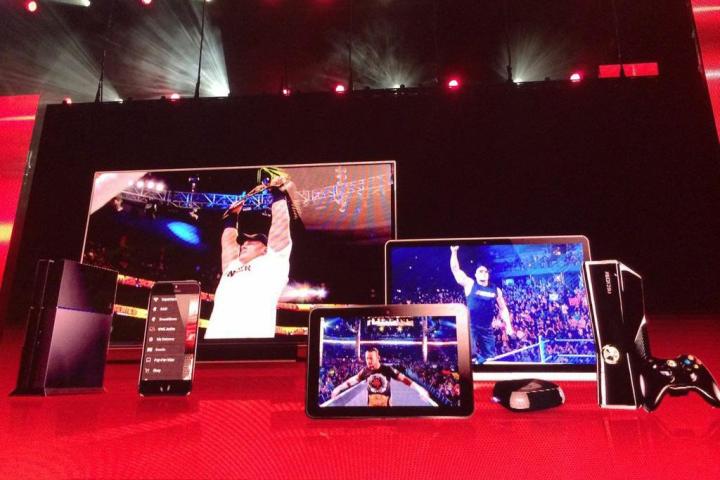
Choke slams, leg drops, and piledrivers aren’t for everyone. But even if you aren’t into the WWE’s unique brand of ‘sports entertainment,’ you should be interested in its latest big move: the WWE Network. Because it could finally prove to other sports networks that streaming works, and help complete the programming puzzle for cordcutters.
WWE Network explained
Unveiled during the Consumer Electronics Show this year (a first for WWE), the Network is the first of its kind, fully blending a 24/7 live Internet streaming wrestling channel with Netflix-style on-demand content. And like Netflix, it will launch on almost every major platform – Web, PlayStation, Xbox, Android, iOS, Kindle Fire, Roku, Chromecast, and more. Fans can subscribe for $10 a month (with a six-month commitment).
You can bet that ESPN will watch WWE’s quarterly reports like a hawk.
Though WWE currently charges up to $55 for each of its 12 monthly pay-per-view events, headlined by WrestleMania each year, it’s giving subscribers live streaming access to these events at no additional cost. Episodes of the company’s premiere programs, Monday Night Raw and Friday Night SmackDown, will premiere directly after they air on TV, and the WWE is developing a suite of original programming, like Legend’s House, where it places classic wrestlers like Rowdy Roddy Piper in a house together. Some of its action movies will make it on there as well, along with 1,500+ hours of classic archive content from great matches of the past.
A massive gamble that could triple WWE’s revenue
The WWE is transforming itself from a sports-like organization that broadcasts on network TV to the most complex Internet TV service we’ve ever seen. It’s app even has built-in second screen experiences so you can look at information on a tablet or phone while you stream content on your TV. WWE believes in the Net so much that it’s risking its entire pay-per-view business – a technology that it helped pioneer with the first WrestleMania in 1985.
The service is a life-threatening gamble because pay-per-view events have been a fundamental part of WWE’s business model since the days of Hulk Hogan, and people still buy them. More than a million people paid a combined $72 million to watch WrestleMania 29 in April 2013. For reference, the WWE only pulled in about $480 million total revenue in 2012. If this streaming network fails, its unlikely that WWE could return to its old ways and charge $45 to $55 for a pay-per-view. That kind of money seems far too high for an increasingly digital audience. The entire brand would be devalued.

WWE claims it only needs 800,000 to 1 million subscribers to break even, reports Variety. Doing some quick math, a million subscribers paying $9.99 a month is a little under $120 million in revenue a year.
However, the lower price could also lure new fans out in droves. The WWE could double its $500 million-ish yearly revenue if it could get a little more than 4 million fans to subscribe to this service. And a larger fanbase would kick back to its traditional TV business, too. Under pressure from the Internet, TV networks are getting desperate for first-broadcast rights of live content, and WWE’s audience is full of young males, which are a lucrative demographic. According to Mike Ozanian of Forbes, the WWE could use this new network as massive leverage to double or triple its broadcast TV rights as well, growing them from about $140 million a year to as much as $420 million.
If WWE wins, other sports will enter the ring
You don’t have to like wrestling or sign up for the WWE Network to realize the significance of this. If the WWE succeeds, it will prove the efficacy of Internet TV far beyond anything Netflix has done to the one group that need convincing most: sports companies.
Internet TV services like Hulu, Netflix, Amazon Prime, and others offer a wide variety of movies and TV shows, but the old cable oligarchy still has a lock on sports content. If you want to watch games on ESPN, NFL, or most sports, you need a cable subscription.
You can bet that ESPN will watch the WWE’s quarterly reports like a hawk; the NFL and other big sports organizations might as well.
If sports broadcasts finally move online, everything will begin to change.
There are almost 220 million WWE fans across the major social networks and WWE is consistently one of the “top 15 most talked about brands on Facebook.” Like the NFL, WWE tours the country (and world), holds live TV broadcasts, and derives much of its revenue from TV ratings, merchandise, and premiere events (it currently holds monthly pay-per-view events, much like boxing and some other sports).
If WWE can prove that the model works, even ESPN could change its exclusivity position with the cable industry. ESPN is the glue holding cable together. It currently pulls in about $5.54 per Cable subscriber in 2013. Right now, there are about 103 million cable subscribers, but they are dropping fast. Still, ESPN is mopping up as cable companies panic. It’s estimated to get about $7.31 billion in cable subscriber revenue in 2014 with a projected $6.54 per subscriber.
To match that revenue, ESPN would need 60 million subscribers at $10 a month, 40.6 million at $15, or 30.5 million at $20 a month. These numbers are daunting but they aren’t unachievable. Netflix, for example, has more than 40 million subscribers. But like the WWE, ESPN could continue to be on cable and start offering a WWE Network-like online service that gives fans the full package. It has more leverage than ever on cable companies and could use that to carve out its upcoming place on the Net. The transition is inevitable; it’s just a matter of when.
A no-holds-barred glimpse into the future
If this gamble pays off big for WWE, and it very well could, it’s going to speed up the move away from cable toward a world of a la cart digital subscriptions. Other sports organizations will join a sea of copycats, reducing the biggest pain point of cutting cable. If the Internet has live TV and sports broadcasts, you don’t need to pay for cable.
Thanks to the WWE, we may look back on Feb. 24, 2014 – the day it launches – as the day the Internet put traditional TV in a figure-four leg lock.


